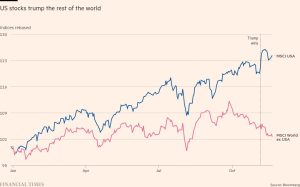In investing, what if bad is good and good is bad?
Unlock the Editor’s Digest for free
Roula Khalaf, Editor of the FT, selects her favourite stories in this weekly newsletter.
As an Aussie bloke, I tell my kids that no good comes of opening up emotionally. But my sobbing about performance in this column a fortnight ago has done wonders. My portfolio has raced to £513,000 and is now 9 per cent up year-to-date.
Recent gains may surprise readers given the escalating violence in the Middle East. Indeed we are regularly told that bad news stymies returns, while positive news helps. With mostly equities in my pension fund, however, I reckon the reverse is true.
How so? Surely wars, pandemics, or 45,000 port operators in the US walking off the job this week, are negative for companies. Likewise, investors learn to fear recessions or inflation resulting in higher wages and input costs.
What seems like “bad for business”, however, can end up a boon. I often think of London Tube strikes, where newspaper front pages always scream of the billions of pounds of economic activity lost.
But a cost-benefit study by the universities of Cambridge and Oxford following the partial closures of the Underground in 2014 calculated a net gain. Analysing 20 days of travelcard data, researchers found that a substantial number of commuters were forced to explore alternative routes.
No kidding. What was interesting though was that 5 per cent of them stuck to their new way of getting to work after the strikes ended, suggesting their old route was suboptimal. Because the time saved is lasting, the net present benefit was positive.
I have always been a huge fan of Michael Porter’s — mostly unprovable — hypothesis from an article in 1991 that constraints (environmental regulations in this case) improve efficiencies by making companies think outside the box.
Strong unionised labour, as another example, can restrict bosses lazily firing workers when the going gets tough, forcing businesses to innovate or invest in the latest machinery. Or so my left-leaning college tutor suggested three decades ago.
A lifetime of analysing stocks and economic data has warmed me further to the merits of this idea. Companies need some pain in order for all stakeholders to thrive. The trouble is that for long periods of my career, shareholder returns have come too easily.
With due respect to the many chief executives I have met, frankly an axolotl could have done just as good a job. Stagnant real wages, ultra-low borrowing costs, and input cost deflation have all elevated profit margins — with few grey cells required.
And little investment too. Capex as a percentage of output has fallen in most developed economies around the world in the past 30 years. Some of this decline is due to capital goods becoming cheaper, but firms also haven’t needed to spend.
Yet productivity growth will only regain its mid-1990s va-va-voom if companies embrace the latest technologies and processes. And they will only invest if the easy wins they have long enjoyed are denied them.
Hence when everyone is fretting about rising interest rates, I’m glad managers have to worry about more expensive capital. In fact, I am told by friends in private equity this is one reason they like to burden their companies with debt: it keeps bosses on their toes.
Similarly I have no problem with the new Labour government taxing UK companies more. And I hope a potential Trump administration wouldn’t reduce what US firms have to pay. Higher wages? No problem! There is a long-run positive correlation in the US between nominal incomes and productivity growth.
In my view, a lack of discomfort in C-suites is partly the answer to what economists call the productivity puzzle. It’s a hard sell, though. “Bad is good” is counterintuitive, and few chief executives will hop on stage asking for business conditions to worsen.
Banks and portfolio managers are also transfixed by the “bad news is bad for investors” narrative. An incredible 93 per cent of them in the UK, for example, responded to a recent Bank of England survey putting geopolitical risks as their top concern — the highest proportion ever.
Thank goodness there are lots of ways to put pressure on companies while still praying for peace the world over. A rising yen for decades up until 1995 forced Japanese firms to innovate off the charts. Once it started weakening it was sayonara Sony, hello Apple.
This is why I’m cheering the recovery in the yen since July. I don’t want Japanese exporters enjoying life too much. And just because I own energy stocks doesn’t mean I’m pro higher oil prices or anti the green transition. No, a vulnerable Exxon is fine by me.
The biggest jump in value in my portfolio over the past month or so has been driven by Asian stocks, namely the rebound in China. Hedge funds (having clearly been reading this column) made record net purchases in September, according to Bloomberg data.
But whereas most investors are betting on economic green shoots or mega Beijing stimulus measures, I hope that conditions remain just hard enough for Chinese companies to make the reforms necessary to emerge stronger.
Does “no pain no gain” always hold? Certainly not with start-ups, I would argue. Take artificial intelligence: while Brussels wants to lead the world in regulating it, the latest capital raise by Open AI makes it more valuable than all but 17 European companies.
And what of the bull run in global equities? The S&P 500 reached an all-time high on Monday. Seems that investor returns have been perfectly fine without the corporate suffering thanks very much.
They have — but what of the longer term? Meanwhile, the economic and social costs of a lack of innovation and capex are well documented. As investors, like parenting, we must make sure we don’t always favour the easy options. Easier said than done.
The author is a former portfolio manager. Email: [email protected]; Twitter: @stuartkirk__
#investing #bad #good #good #bad




